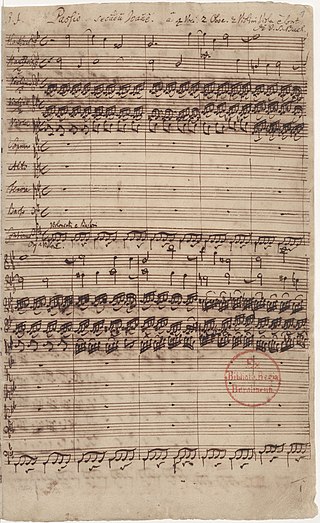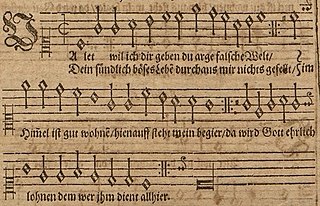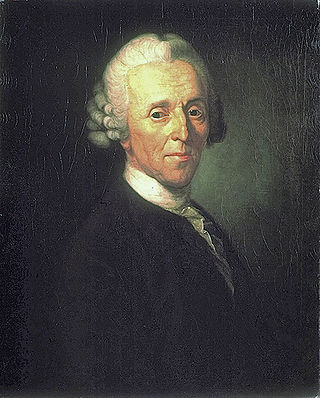Related Research Articles

Johann Sebastian Bach composed the church cantata Christ unser Herr zum Jordan kam, BWV 7, in Leipzig for the Feast of St. John the Baptist and led its first performance on 24 June 1724.

"Herzliebster Jesu" is a Lutheran Passion hymn in German, written in 1630 by Johann Heermann, in 15 stanzas of 4 lines, first published in Devoti Musica Cordis in Breslau. As the original headline reveals, it is based on Augustine of Hippo; this means the seventh chapter of the so-called "Meditationes Divi Augustini", presently ascribed to John of Fécamp.

The Passio secundum Joannem or St John Passion, BWV 245, is a Passion or oratorio by Johann Sebastian Bach, the older of the surviving Passions by Bach. It was written during his first year as director of church music in Leipzig and was first performed on April 7, 1724, at Good Friday Vespers at the St. Nicholas Church.

"O Sacred Head, Now Wounded" is a Christian Passion hymn based on a Latin text written during the Middle Ages. Paul Gerhardt wrote a German version which is known by its incipit, "O Haupt voll Blut und Wunden".

Sehet, wir gehn hinauf gen Jerusalem, BWV 159, is a church cantata by Johann Sebastian Bach. He composed it in Leipzig for the Sunday Estomihi, the last Sunday before Lent, and probably first performed it on 27 February 1729. The gospel reading for the Sunday, from the Gospel of Luke, includes Jesus announcing his suffering and death in Jerusalem. The cantata's theme and Bach's music foreshadow his Passion.
Michael Weiße or Weisse was a German theologian, Protestant reformer and hymn writer. First a Franciscan, he joined the Bohemian Brethren. He published the most extensive early Protestant hymnal in 1531, supplying most hymn texts and some tunes himself. One of his hymns was used in Johann Sebastian Bach's St John Passion.
Paul or Paulus Stockmann was a German academic, preacher and hymn-writer. He fought at the Battle of Lützen in 1632 and later served as court preacher to Gustavus Adolphus of Sweden, before dying of the plague in 1636.

The structure of the St John Passion, BWV 245, a sacred oratorio by Johann Sebastian Bach first performed in Leipzig on Good Friday 1724, is "carefully designed with a great deal of musico-theological intent". Some main aspects of the structure are shown in tables below.

"O Welt, sieh hier dein Leben" is a Lutheran Passion hymn in German by Paul Gerhardt. In 16 stanzas of 6 lines, it was first published in 1647 in Johann Crüger's Praxis pietatis melica. The hymn is known as the source for chorales in Bach's Passions. It was translated to English in several versions, for example "O, World! behold upon the tree" by Catherine Winkworth in 1858.
"Herzlich lieb hab ich dich, o Herr" is a Lutheran hymn in German by the Protestant theologian and reformer Martin Schalling, written in Amberg in 1569 and first printed in 1571. It is sung to an anonymous melody, Zahn No. 8326, which appeared in a tablature book for organ in 1577. The hymn is often used for funerals, especially the third and last stanza, "Ach Herr, laß dein lieb Engelein". It appears in the current German Protestant hymnal Evangelisches Gesangbuch (EG).

"Valet will ich dir geben" is a Lutheran hymn written by Valerius Herberger in 1613. It is a Sterbelied. The text was published with two hymn tunes by Melchior Teschner, Zahn Nos. 5403 and 5404a, in 1615. The second of these melodies was used in compositions such as chorale preludes by Johann Sebastian Bach and Max Reger. Bach used single stanzas in vocal works, including his St John Passion.

"O Lamm Gottes, unschuldig" is an early Lutheran hymn, with text and melody attributed to Nikolaus Decius. Originally intended as a German version of the Latin Agnus Dei, it was instead used as a Passion hymn. In both contexts, the hymn has often been set to music, prominently as the cantus firmus in the opening chorus of Bach's St. Matthew Passion. It is included in most German hymnals, and has been translated by Catherine Winkworth, among others.

"O Mensch, bewein' dein' Sünde groß" is a Lutheran Passion hymn with a text written by Sebald Heyden in 1530. The author reflects the Passion of Jesus, based on the Four Evangelists, originally in 23 stanzas. The lyrics were written for an older melody, "Es sind doch selig alle, die im rechten Glauben wandeln". The first and last stanzas have appeared in 11 hymnals. Catherine Winkworth translated it as "O man, thy grievous sin bemoan". The hymn has been used in Passion music and is known in Bach's setting as a chorale fantasia closing Part I of his St Matthew Passion.

"Christe, du Lamm Gottes" is a Lutheran hymn, often referred to as the German Agnus Dei. Martin Luther wrote the words of the hymn as a translation of the Latin Agnus Dei from the liturgy of the mass. The tune, Zahn 58, was taken from an older liturgy. The hymn was first published in 1528 and has been the basis for several musical settings by composers such as Bach, Mendelssohn and Hessenberg. It appears in modern German hymnals, both the Protestant Evangelisches Gesangbuch and the Catholic Gotteslob.

"In dich hab ich gehoffet, Herr" is a Lutheran hymn in seven stanzas, written by Adam Reusner and first published in 1533. He paraphrased the beginning of Psalm 31. It was first sung to the melody of a Passion hymn. The melody connected with the hymn in 1560 was derived from models dating back to the 14th century. A third melody from 1608 became a hymn tune for several other songs and translations to English. In the German Protestant hymnal Evangelisches Gesangbuch, the hymn appears as EG 257 with the second melody. Johann Sebastian Bach used the second and third melodies in chorale preludes, and the third also in cantatas and the St Matthew Passion.
"Befiehl du deine Wege" is a Lutheran hymn by Paul Gerhardt. It is one of his best known hymns, and was first published in 1653 in Johann Crüger's collection of hymns and popular religious songs Praxis pietatis melica.
"Jesu Leiden, Pein und Tod" is a German Lutheran hymn by Paul Stockmann. Written in 34 stanzas and published in 1633, it narrates the Passion of Jesus. It was sung to a melody by Melchior Vulpius. Johann Sebastian Bach used three of its stanzas as chorales in his St John Passion.

"Christus, der uns selig macht" is a German Lutheran Passion hymn in eight stanzas in German by Michael Weiße, written in 1531 as a translation of the Latin hymn "Patris Sapientia" to an older melody of the Bohemian Brethren.

"Ein Lämmlein geht und trägt die Schuld" is a Lutheran Passion hymn in German by Paul Gerhardt. The hymn text was first published in Johann Crüger's Praxis Pietatis Melica, starting from the lost 1647 edition. Wolfgang Dachstein's 16th-century "An Wasserflüssen Babylon" melody is commonly indicated as its hymn tune, although other settings exist.

"Herr, stärke mich, dein Leiden zu bedenken" is a Passion hymn in German, written by Christian Fürchtegott Gellert to the melody of "Herzliebster Jesu", and first published in 1757. It is contained in the German Protestant hymnal Evangelisches Gesangbuch.
References
- ↑ Lyon, James (2005). Johann Sebastian Bach: Chorals. Guides musicologiques (in French). Vol. 6. Beauchesne. pp. 145–146. ISBN 270101493X. ISSN 0246-3865.